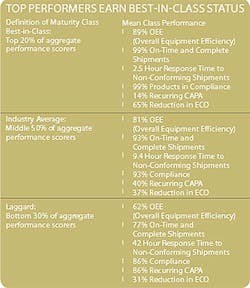Managing Quality from Design to Delivery
Sept. 1, 2009
3 min read
If we examine the design-make-deliver processes, there are a number of workflows in which an incorporation of enterprise quality management processes would yield tangible benefits. The results of our research in closed-loop enterprise quality management identified how Best-in-Class manufacturers are effectively ensuring quality throughout these processes.The top pressures driving manufacturers to focus on enterprise quality management initiatives are the need to ensure customer satisfaction and the need to reduce the cost of quality. Both of these pressures were at the top of the list in last year’s study and both were selected by a majority of survey respondents this year, making it clear that these issues resonate in any economic climate. Aberdeen Group uses six key performance criteria to distinguish the Best-in-Class from Industry Average and Laggard organizations, and found through this analysis that Best-in-Class companies are gaining significant competitive advantage when compared with Industry Average and Laggards. The top strategic action, as was the case with market pressures, has remained the same since last year. The market at large is still most concerned with improving the visibility and control of quality processes. The real surprise this year, in regard to strategic actions, is the movement of the strategy regarding improving collaboration across the enterprise from fourth last year to second this year. Such a move could be signaling a maturation of the market in regard to the understanding of quality processes and that quality truly is more than scrap, rework or recalls; that it takes the combined effort of the entire value chain to make substantive improvements to quality execution.Collaboration can be a challenging but worthwhile undertaking. The question is where the focus of this collaboration should be placed to exact the most positive impact on the business and ultimately, corporate performance. Our research shows that the focus should be placed at the intersection points of the design-make-deliver business processes.To create a competitive advantage in today’s marketplace, it is critical for organizations to successfully innovate. This means that companies must be able to deliver new products to market on time, on quality and on volume, but none of these objectives can be singularly delivered by the product design, manufacturing or supply chain organizations. In fact, the degree to which these organizations successfully collaborate and address adverse events goes a long way in determining the achievement of time, quality and volume metrics.Technology platformOne of the key enablers of collaboration is technology. Successfully implementing a closed-loop enterprise quality management system involves the elevation of quality management to the enterprise level and building quality into the main business processes of any manufacturing organization. Accomplishing this involves both executive vision and an information technology (IT) strategy. It also involves deploying a number of traditional quality tools such as document management, corrective and preventive actions (CAPA), failure mode and effects analysis (FMEA), audit management and others, but again, the deployment of these technology enablers should be at the enterprise level. Additionally, a risk-based approach should be taken for the use of these systems, which means that efforts in these areas should be transitioned from one that just achieves compliance to one that reduces the overall risk profile of the organization and positively impacts key metrics for the organization.Matthew Littlefield, [email protected], is Senior Research Analyst, and Mehul Shah, [email protected], is Research Analyst, at Aberdeen Group Inc., in Boston.
Subscribe to Automation World's RSS Feeds for Columns & Departments
About the Author
Sign up for our eNewsletters
Get the latest news and updates

Leaders relevant to this article:
